Emerson IFT9701 User Manual

Instruction Manual
P/N 3100572, Rev. E
March 2004
Micro Motion®
Model IFT9701 Transmitter with Optional Display
Instruction Manual
Micro MotionTM 





Micro Motion®
Model IFT9701 Transmitter with Optional Display
Instruction Manual
For online technical support, refer to the EXPERT2™ tool at www.expert2.com. To speak to a customer service representative, call the support center nearest you:
•In U.S.A., phone 1-800-522-MASS (1-800-522-6277)
•In Canada and Latin America, phone (303) 530-8400
•In Asia, phone (65) 6770-8155
•In the U.K., phone 0800 - 966 180 (toll-free)
•Outside the U.K., phone +31 (0) 318 495 670
©2004, Micro Motion, Inc. All rights reserved. Micro Motion is a registered trademark of Micro Motion, Inc. The Micro Motion and Emerson logos are trademarks of Emerson Electric Co. All other trademarks are property of their respective owners.
Contents
Chapter 1 Before You Begin . . . . . . . . . . . . . . . . . . . . . . . . . . . . . . . . . . . . . 1
1.1 About this manual . . . . . . . . . . . . . . . . . . . . . . . . . . . . . . . . . . . . . . . . . . . . . . . . . . . . 1 1.2 Safety . . . . . . . . . . . . . . . . . . . . . . . . . . . . . . . . . . . . . . . . . . . . . . . . . . . . . . . . . . . . . 1 1.3 European installations. . . . . . . . . . . . . . . . . . . . . . . . . . . . . . . . . . . . . . . . . . . . . . . . . 2 1.4 Definitions . . . . . . . . . . . . . . . . . . . . . . . . . . . . . . . . . . . . . . . . . . . . . . . . . . . . . . . . . . 2 1.5 Flowmeter components. . . . . . . . . . . . . . . . . . . . . . . . . . . . . . . . . . . . . . . . . . . . . . . . 2
Chapter 2 Getting Started. . . . . . . . . . . . . . . . . . . . . . . . . . . . . . . . . . . . . . . 5
2.1 Safety, reliability, accessibility . . . . . . . . . . . . . . . . . . . . . . . . . . . . . . . . . . . . . . . . . . . 5 2.1.1 Hazardous area . . . . . . . . . . . . . . . . . . . . . . . . . . . . . . . . . . . . . . . . . . . . . 5 2.1.2 Orientation and mounting . . . . . . . . . . . . . . . . . . . . . . . . . . . . . . . . . . . . . 6 2.1.3 Temperature, humidity, and vibration . . . . . . . . . . . . . . . . . . . . . . . . . . . . . 6 2.1.4 Visibility of tags . . . . . . . . . . . . . . . . . . . . . . . . . . . . . . . . . . . . . . . . . . . . . 7
2.2 Transmitters approved for ATEX Zone 1 . . . . . . . . . . . . . . . . . . . . . . . . . . . . . . . . . . . 7 2.3 Jumper settings. . . . . . . . . . . . . . . . . . . . . . . . . . . . . . . . . . . . . . . . . . . . . . . . . . . . . . 8 2.3.1 Security . . . . . . . . . . . . . . . . . . . . . . . . . . . . . . . . . . . . . . . . . . . . . . . . . . . 9 2.3.2 Fault output levels . . . . . . . . . . . . . . . . . . . . . . . . . . . . . . . . . . . . . . . . . . . 9 2.3.3 Re-installing the circuit board compartment cover. . . . . . . . . . . . . . . . . . 10
Chapter 3 Remotely Mounting the Transmitter . . . . . . . . . . . . . . . . . . . . . . . |
11 |
3.1 Overview . . . . . . . . . . . . . . . . . . . . . . . . . . . . . . . . . . . . . . . . . . . . . . . . . . . . . . . . . . 11 3.2 Choosing the proper location . . . . . . . . . . . . . . . . . . . . . . . . . . . . . . . . . . . . . . . . . . 11 3.3 Mounting the transmitter . . . . . . . . . . . . . . . . . . . . . . . . . . . . . . . . . . . . . . . . . . . . . . 11 3.3.1 Guidelines for flat-surface mounting . . . . . . . . . . . . . . . . . . . . . . . . . . . . 11 3.3.2 Guidelines for pole mounting . . . . . . . . . . . . . . . . . . . . . . . . . . . . . . . . . . 11
3.4 Connecting the transmitter to the sensor . . . . . . . . . . . . . . . . . . . . . . . . . . . . . . . . . 14 3.4.1 Cable types . . . . . . . . . . . . . . . . . . . . . . . . . . . . . . . . . . . . . . . . . . . . . . . 14 3.4.2 Guidelines for conduit . . . . . . . . . . . . . . . . . . . . . . . . . . . . . . . . . . . . . . . 16 3.4.3 Guidelines for cable gland . . . . . . . . . . . . . . . . . . . . . . . . . . . . . . . . . . . . 16 3.4.4 Wiring connections to sensor. . . . . . . . . . . . . . . . . . . . . . . . . . . . . . . . . . 16
Chapter 4 Power Supply and Output Wiring . . . . . . . . . . . . . . . . . . . . . . . . . |
19 |
4.1 Overview . . . . . . . . . . . . . . . . . . . . . . . . . . . . . . . . . . . . . . . . . . . . . . . . . . . . . . . . . . 19 4.2 Wiring guidelines. . . . . . . . . . . . . . . . . . . . . . . . . . . . . . . . . . . . . . . . . . . . . . . . . . . . 19 4.3 Connect power supply wiring . . . . . . . . . . . . . . . . . . . . . . . . . . . . . . . . . . . . . . . . . . 20 4.4 Connect output wiring . . . . . . . . . . . . . . . . . . . . . . . . . . . . . . . . . . . . . . . . . . . . . . . . 21 4.4.1 Milliamp output. . . . . . . . . . . . . . . . . . . . . . . . . . . . . . . . . . . . . . . . . . . . . 22 4.4.2 Milliamp output connected to Bell 202 multidrop network . . . . . . . . . . . . 23 4.4.3 Communication tools connected to milliamp output. . . . . . . . . . . . . . . . . 24 4.4.4 Pulse output . . . . . . . . . . . . . . . . . . . . . . . . . . . . . . . . . . . . . . . . . . . . . . . 25
Model IFT9701 Transmitter Instruction Manual |
i |
Contents continued
Chapter 5 Flowmeter Startup . . . . . . . . . . . . . . . . . . . . . . . . . . . . . . . . . . . |
29 |
5.1 Overview . . . . . . . . . . . . . . . . . . . . . . . . . . . . . . . . . . . . . . . . . . . . . . . . . . . . . . . . . . 29 5.2 Customer service . . . . . . . . . . . . . . . . . . . . . . . . . . . . . . . . . . . . . . . . . . . . . . . . . . . 29 5.3 Startup procedures . . . . . . . . . . . . . . . . . . . . . . . . . . . . . . . . . . . . . . . . . . . . . . . . . . 29 5.4 Initialization . . . . . . . . . . . . . . . . . . . . . . . . . . . . . . . . . . . . . . . . . . . . . . . . . . . . . . . . 30 5.4.1 Diagnostic LED . . . . . . . . . . . . . . . . . . . . . . . . . . . . . . . . . . . . . . . . . . . . 30 5.4.2 Optional display . . . . . . . . . . . . . . . . . . . . . . . . . . . . . . . . . . . . . . . . . . . . 30 5.4.3 Startup mode . . . . . . . . . . . . . . . . . . . . . . . . . . . . . . . . . . . . . . . . . . . . . . 30 5.4.4 Operating mode. . . . . . . . . . . . . . . . . . . . . . . . . . . . . . . . . . . . . . . . . . . . 30
5.5 Flowmeter zeroing . . . . . . . . . . . . . . . . . . . . . . . . . . . . . . . . . . . . . . . . . . . . . . . . . . 31 5.5.1 Zeroing procedure . . . . . . . . . . . . . . . . . . . . . . . . . . . . . . . . . . . . . . . . . . 31 5.5.2 Diagnosing zero failure . . . . . . . . . . . . . . . . . . . . . . . . . . . . . . . . . . . . . . 32
5.6 Configuration, calibration, and characterization . . . . . . . . . . . . . . . . . . . . . . . . . . . . 32 5.7 Process measurement . . . . . . . . . . . . . . . . . . . . . . . . . . . . . . . . . . . . . . . . . . . . . . . 33
Chapter 6 Configuration with a HART Communicator . . . . . . . . . . . . . . . . . . . |
35 |
6.1 Configuration overview . . . . . . . . . . . . . . . . . . . . . . . . . . . . . . . . . . . . . . . . . . . . . . . 35 6.2 Configuration parameters . . . . . . . . . . . . . . . . . . . . . . . . . . . . . . . . . . . . . . . . . . . . . 36 6.2.1 HART tag . . . . . . . . . . . . . . . . . . . . . . . . . . . . . . . . . . . . . . . . . . . . . . . . . 36 6.2.2 Measurement units . . . . . . . . . . . . . . . . . . . . . . . . . . . . . . . . . . . . . . . . . 36 6.2.3 Flow cutoff . . . . . . . . . . . . . . . . . . . . . . . . . . . . . . . . . . . . . . . . . . . . . . . . 38 6.2.4 Damping . . . . . . . . . . . . . . . . . . . . . . . . . . . . . . . . . . . . . . . . . . . . . . . . . 38 6.2.5 Flow direction. . . . . . . . . . . . . . . . . . . . . . . . . . . . . . . . . . . . . . . . . . . . . . 39 6.2.6 Range values for milliamp output . . . . . . . . . . . . . . . . . . . . . . . . . . . . . . 40 6.2.7 Pulse output scaling . . . . . . . . . . . . . . . . . . . . . . . . . . . . . . . . . . . . . . . . 40
6.3 Calibration procedures . . . . . . . . . . . . . . . . . . . . . . . . . . . . . . . . . . . . . . . . . . . . . . . 41 6.3.1 Auto zero . . . . . . . . . . . . . . . . . . . . . . . . . . . . . . . . . . . . . . . . . . . . . . . . . 41 6.3.2 Flow calibration procedure. . . . . . . . . . . . . . . . . . . . . . . . . . . . . . . . . . . . 42
6.4 Characterization . . . . . . . . . . . . . . . . . . . . . . . . . . . . . . . . . . . . . . . . . . . . . . . . . . . . 44
Chapter 7 Configuration with ProLink II Software . . . . . . . . . . . . . . . . . . . . . |
45 |
7.1 Configuration overview . . . . . . . . . . . . . . . . . . . . . . . . . . . . . . . . . . . . . . . . . . . . . . . 45 7.2 Configuration parameters . . . . . . . . . . . . . . . . . . . . . . . . . . . . . . . . . . . . . . . . . . . . . 46 7.2.1 HART tag . . . . . . . . . . . . . . . . . . . . . . . . . . . . . . . . . . . . . . . . . . . . . . . . . 46 7.2.2 Process variable measurement . . . . . . . . . . . . . . . . . . . . . . . . . . . . . . . . 47 7.2.3 Output configuration . . . . . . . . . . . . . . . . . . . . . . . . . . . . . . . . . . . . . . . . 50
7.3 Calibration procedures . . . . . . . . . . . . . . . . . . . . . . . . . . . . . . . . . . . . . . . . . . . . . . . 51 7.3.1 Auto zero . . . . . . . . . . . . . . . . . . . . . . . . . . . . . . . . . . . . . . . . . . . . . . . . . 51 7.3.2 Flow calibration procedure. . . . . . . . . . . . . . . . . . . . . . . . . . . . . . . . . . . . 53
7.4 Characterization . . . . . . . . . . . . . . . . . . . . . . . . . . . . . . . . . . . . . . . . . . . . . . . . . . . . 55
Chapter 8 Troubleshooting . . . . . . . . . . . . . . . . . . . . . . . . . . . . . . . . . . . . . |
57 |
8.1 Customer service . . . . . . . . . . . . . . . . . . . . . . . . . . . . . . . . . . . . . . . . . . . . . . . . . . . 57 8.2 General guidelines . . . . . . . . . . . . . . . . . . . . . . . . . . . . . . . . . . . . . . . . . . . . . . . . . . 57 8.3 Transmitter diagnostic tools . . . . . . . . . . . . . . . . . . . . . . . . . . . . . . . . . . . . . . . . . . . 57 8.3.1 Diagnostic LED . . . . . . . . . . . . . . . . . . . . . . . . . . . . . . . . . . . . . . . . . . . . 57 8.3.2 Optional LCD . . . . . . . . . . . . . . . . . . . . . . . . . . . . . . . . . . . . . . . . . . . . . . 58 8.3.3 Fault outputs . . . . . . . . . . . . . . . . . . . . . . . . . . . . . . . . . . . . . . . . . . . . . . 58
8.4 Power supply. . . . . . . . . . . . . . . . . . . . . . . . . . . . . . . . . . . . . . . . . . . . . . . . . . . . . . . 59 8.5 Wiring . . . . . . . . . . . . . . . . . . . . . . . . . . . . . . . . . . . . . . . . . . . . . . . . . . . . . . . . . . . . 60 8.6 Over range and sensor failure conditions . . . . . . . . . . . . . . . . . . . . . . . . . . . . . . . . . 61
ii |
Model IFT9701 Transmitter Instruction Manual |
Contents continued
8.7 Slug flow . . . . . . . . . . . . . . . . . . . . . . . . . . . . . . . . . . . . . . . . . . . . . . . . . . . . . . . . . . 62 8.8 Transmitter failure . . . . . . . . . . . . . . . . . . . . . . . . . . . . . . . . . . . . . . . . . . . . . . . . . . . 63 8.9 Digital diagnostic messages . . . . . . . . . . . . . . . . . . . . . . . . . . . . . . . . . . . . . . . . . . . 63
Appendix A IFT9701 Specifications . . . . . . . . . . . . . . . . . . . . . . . . . . . . . . . . |
65 |
A.1 Performance specifications . . . . . . . . . . . . . . . . . . . . . . . . . . . . . . . . . . . . . . . . . . . . 65 A.2 Functional specifications . . . . . . . . . . . . . . . . . . . . . . . . . . . . . . . . . . . . . . . . . . . . . . 65 A.2.1 Output signals . . . . . . . . . . . . . . . . . . . . . . . . . . . . . . . . . . . . . . . . . . . . . 65 A.2.2 Local display (optional) . . . . . . . . . . . . . . . . . . . . . . . . . . . . . . . . . . . . . . 66 A.2.3 Low-flow cutoff . . . . . . . . . . . . . . . . . . . . . . . . . . . . . . . . . . . . . . . . . . . . . 66 A.2.4 Slug-flow inhibit . . . . . . . . . . . . . . . . . . . . . . . . . . . . . . . . . . . . . . . . . . . . 66 A.2.5 Damping. . . . . . . . . . . . . . . . . . . . . . . . . . . . . . . . . . . . . . . . . . . . . . . . . . 66 A.2.6 Fault indication . . . . . . . . . . . . . . . . . . . . . . . . . . . . . . . . . . . . . . . . . . . . . 66 A.2.7 Output testing. . . . . . . . . . . . . . . . . . . . . . . . . . . . . . . . . . . . . . . . . . . . . . 66 A.2.8 Power supply options . . . . . . . . . . . . . . . . . . . . . . . . . . . . . . . . . . . . . . . . 66
A.3 Environmental limits . . . . . . . . . . . . . . . . . . . . . . . . . . . . . . . . . . . . . . . . . . . . . . . . . 67 A.3.1 Temperature. . . . . . . . . . . . . . . . . . . . . . . . . . . . . . . . . . . . . . . . . . . . . . . 67 A.3.2 Process fluid temperature limits. . . . . . . . . . . . . . . . . . . . . . . . . . . . . . . . 67 A.3.3 Humidity limits . . . . . . . . . . . . . . . . . . . . . . . . . . . . . . . . . . . . . . . . . . . . . 68 A.3.4 Vibration limits . . . . . . . . . . . . . . . . . . . . . . . . . . . . . . . . . . . . . . . . . . . . . 68
A.4 Density limits . . . . . . . . . . . . . . . . . . . . . . . . . . . . . . . . . . . . . . . . . . . . . . . . . . . . . . . 68 A.5 Environmental effects . . . . . . . . . . . . . . . . . . . . . . . . . . . . . . . . . . . . . . . . . . . . . . . . 68 A.6 Ambient temperature effect on milliamp output. . . . . . . . . . . . . . . . . . . . . . . . . . . . . 69 A.7 Shipping weight. . . . . . . . . . . . . . . . . . . . . . . . . . . . . . . . . . . . . . . . . . . . . . . . . . . . . 69 A.8 Hazardous area classifications . . . . . . . . . . . . . . . . . . . . . . . . . . . . . . . . . . . . . . . . . 69
Appendix B HART Communicator Menu Trees . . . . . . . . . . . . . . . . . . . . . . . . . |
71 |
|
Appendix C Installing the Optional Display . . . . . . . . . . . . . . . . . . . . . . . . . . . |
73 |
|
Appendix D Return Policy. . . . . . . . . . . . . . . . . . . . . . . . . . . . . . . . . . . . . . . |
75 |
|
D.1 |
General guidelines . . . . . . . . . . . . . . . . . . . . . . . . . . . . . . . . . . . . . . . . . . . . . . . . . . |
75 |
D.2 |
New and unused equipment . . . . . . . . . . . . . . . . . . . . . . . . . . . . . . . . . . . . . . . . . . . |
75 |
D.3 |
Used equipment . . . . . . . . . . . . . . . . . . . . . . . . . . . . . . . . . . . . . . . . . . . . . . . . . . . . |
75 |
Index . . . . . . . . . |
. . . . . . . . . . . . . . . . . . . . . . . . . . . . . . . . . . . . . . . . . . . . |
77 |
Model IFT9701 Transmitter Instruction Manual |
iii |
iv |
Model IFT9701 Transmitter Instruction Manual |

Chapter 1
Before You Begin
1.1About this manual
This instruction manual explains how to install, start up, configure, and troubleshoot the Micro Motion IFT9701 transmitter for use with Micro Motion Coriolis flow sensors. For more information about the sensor, see the appropriate sensor instruction manual.
1.2Safety
Safety messages are provided throughout this manual to protect personnel and equipment. Read each safety message carefully before proceeding to the next step.


 WARNING
WARNING
Improper installation in a hazardous area can cause an explosion.
For information about hazardous applications, refer to Micro Motion ATEX, CSA, or UL installation instructions, shipped with the transmitter or available from the Micro Motion web site.


 WARNING
WARNING
Hazardous voltage can cause severe injury or death.
Make sure power is disconnected before installing transmitter.


 CAUTION
CAUTION
Improper installation could cause measurement error or transmitter failure.
Follow all instructions to ensure transmitter will operate correctly.
Begin You Before
Started Getting
Transmitter Remote the Mounting
Wiring Output and Supply Power
Model IFT9701 Transmitter Instruction Manual |
1 |
|
|
|
|
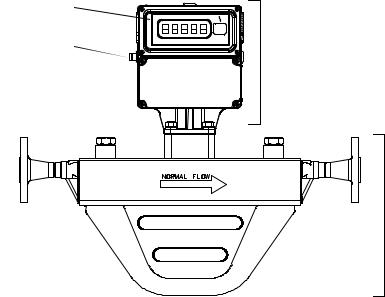
Before You Begin continued
1.3European installations
This Micro Motion product complies with all applicable European directives when properly installed in accordance with the instructions in this manual. Refer to the EC declaration of conformity for directives that apply to this product.
The EC declaration of conformity, with all applicable European directives, and the complete ATEX Installation Drawings and Instructions are available on the internet at www.micromotion.com/atex or through your local Micro Motion support center.
1.4Definitions
•The term “sensor” refers to a Micro Motion sensor only.
•The term “flowmeter” refers to an IFT9701 transmitter and a sensor installed as a flowmetering system.
1.5Flowmeter components
The IFT9701 transmitter can be integrally mounted to a Micro Motion F-Series sensor, or remotely mounted from an ELITE®, F-Series, Model D, or Model DL sensor.
The IFT9701 transmitter does not operate with Micro Motion T-Series, R-Series, or Model D600 or DT sensors.
•If the transmitter is integrally mounted to the sensor, the flowmeter includes the components shown in Figure 1-1.
•If the transmitter will be remotely mounted from the sensor, the transmitter includes the components shown in Figure 1-2.
The transmitter is available with an optional liquid crystal display (LCD), as shown in Figure 1-1 and Figure 1-2, except for ATEX Zone 1 areas.
Figure 1-1 Integrally mounted IFT9701 transmitter with F-Series sensor
Field wiring compartment
With optional LCD
Model
Case ground  IFT9701
IFT9701  transmitter
transmitter
Sensor wiring compartment 
4X M8 mounting bolt
4X lock washer
4X flat washer
To rotate transmitter: remove, then re-install to 12 ft-lb (16 N-m) torque
sensor |
|
Flowmeter |
F-Series |
|
|
|
|
|
2 |
Model IFT9701 Transmitter Instruction Manual |
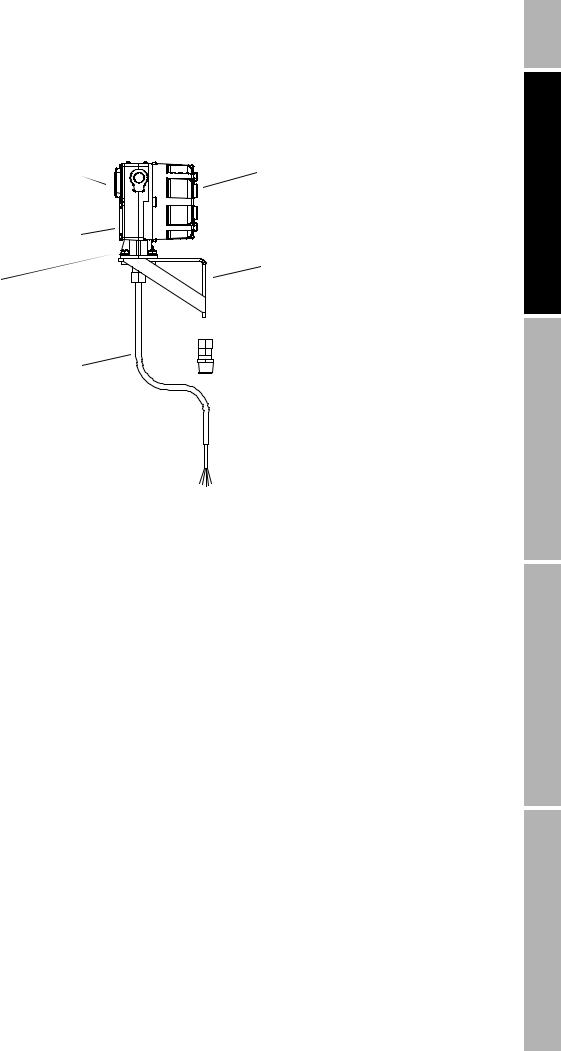
Before You Begin continued
Figure 1-2 Remotely mounted IFT9701 transmitter
|
|
Field wiring |
|
|
compartment |
Model |
|
With optional LCD |
IFT9701 |
|
|
transmitter |
|
Sensor wiring |
|
|
|
|
|
compartment |
|
|
|
4X M8 mounting bolt
•4X lock washer
•4X flat washer
To rotate transmitter: remove, then re-install to 12 ft-lb (16 Nm) torque
Sensor cable
For minimum bend radius of cable, see Figure 3-4, 3-5, or 3-6
If conduit is used, install drip leg in conduit
Circuit board compartment
User access not normally required
Mounting bracket
Requires 4 user-supplied bolts
 Cable gland
Cable gland
•To assemble, see instructions shipped with cable kit
•Connects to sensor junction box
Begin You Before
Started Getting
Transmitter Remote the Mounting
Wiring Output and Supply Power
Model IFT9701 Transmitter Instruction Manual |
3 |
|
|
|
|
4 |
Model IFT9701 Transmitter Instruction Manual |

Chapter 2
Getting Started
2.1Safety, reliability, accessibility


 WARNING
WARNING
Improper installation in a hazardous area could cause an explosion.
Install the transmitter in an environment that is compatible with the hazardous area specified on the approvals tag.
•For intrinsically safe sensor installations, use this document with Micro Motion ATEX, CSA, or UL installation instructions.
•For hazardous area installations in Europe, refer to standard EN 60079-14 if national standards do not apply.
2.1.1Hazardous area
If you plan to mount the transmitter in a hazardous area, ensure that your equipment and installation meet the hazardous area requirements. For more information about hazardous area classifications, see Section A.8. See Figure 2-1 for the location of the approvals tag on your transmitter.
Begin You Before
Started Getting
Transmitter Remote the Mounting
Wiring Output and Supply Power
Model IFT9701 Transmitter Instruction Manual |
5 |
|
|
|
|
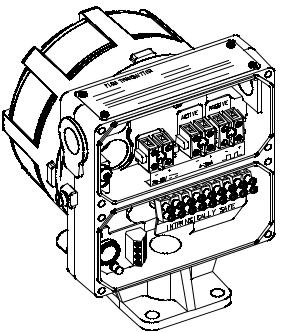
Getting Started continued
Figure 2-1 Location of approvals tag
Hazardous area approvals tag
2.1.2Orientation and mounting
Orient the transmitter so wiring compartments and conduit openings are easily accessible.
•To rotate the transmitter on the sensor manifold or the mounting bracket, use the four supplied mounting bolt assemblies. Each bolt assembly includes one M8 bolt, one lock washer, and one flat washer. Remove the bolt assemblies, rotate the transmitter, then reinstall the bolt assemblies to 12 ft-lb (16 N-m) of torque.
•If the transmitter will be integrally mounted to a Micro Motion F-Series sensor, see the sensor product data sheet for transmitter and sensor dimensions, and see the instruction manual that was shipped with the sensor for information about flowmeter mounting and location.
•If the transmitter will be remotely mounted, use the supplied bolt assemblies to attach the transmitter to the mounting bracket. Attach the bracket to a rigid, stable surface or instrument pole that will not transfer excessive vibration into the transmitter. See Chapter 3 for more information about remote mounting.
2.1.3Temperature, humidity, and vibration
Install the transmitter according to specified limits:
•Ambient temperature
-without optional LCD: –22 to +131 °F (–30 to +55 °C)
-with optional LCD: 32 to 131 °F (0 to 55 °C)
•Humidity: 5 to 95% non-condensing
•Vibration: Meets IEC 68.2.6, 2 g
6 |
Model IFT9701 Transmitter Instruction Manual |
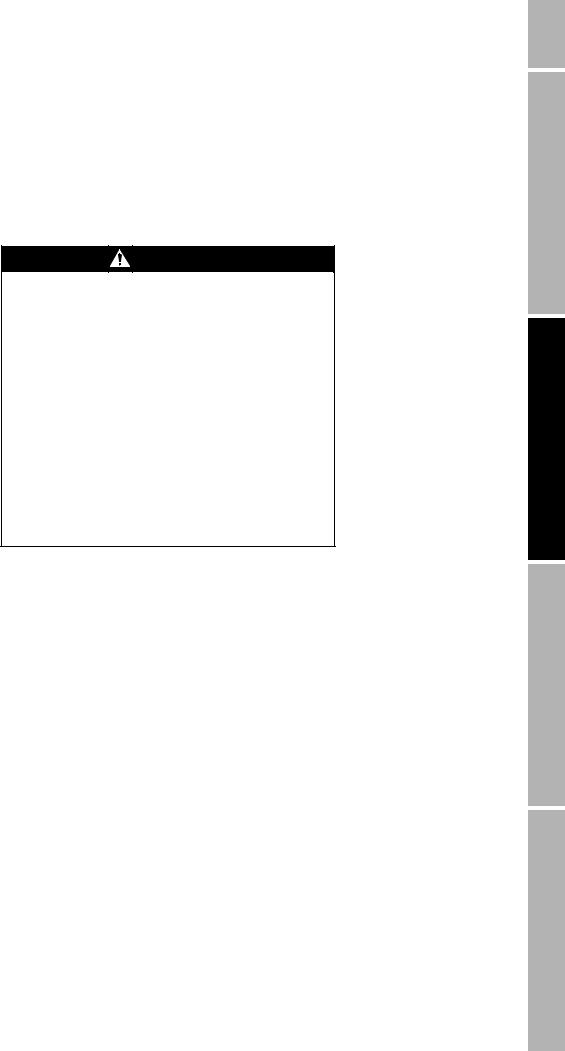
Getting Started continued
2.1.4Visibility of tags
For personal and system safety, all tags attached to the transmitter housing must remain visible. Clean or replace them as necessary.
2.2Transmitters approved for ATEX Zone 1
WARNING |
Explosion hazard
The circuit board compartment is rated EEx d (flameproof), and should remain closed at all times after the flowmeter has been installed.
To avoid risk of explosion in an explosive atmosphere:
•Read label that points to compartment cover before accessing circuit board compartment. Figure 2-2 shows the location of the labels on the transmitter housing.
•Shut off power, and wait at least 2 minutes before removing EEx d (circuit board) compartment cover. Figure 2-2 also identifies the EEx e (field wiring), EEx i (sensor wiring), and EEx d (circuit board) compartments.
If the transmitter carries an ATEX Zone 1 approval, wiring compartments are labeled as shown in Figure 2-2.
•The sensor wiring compartment is rated EEx i (intrinsically safe), and may be opened at any time. See Label 1 in Figure 2-2.
•The field wiring compartment is rated EEx e (increased safety), and should remain closed when power is on. See Label 2 in Figure 2-2.
•The circuit board compartment is rated EEx d (flameproof), and should remain closed at all times after the transmitter has been installed. If the transmitter is approved by ATEX as flameproof, the compartment has a lockout device, shown in Figure 2-2. The lockout device must be loosened and rotated before the compartment cover can be unscrewed.
Begin You Before
Started Getting
Transmitter Remote the Mounting
Wiring Output and Supply Power
Model IFT9701 Transmitter Instruction Manual |
7 |
|
|
|
|
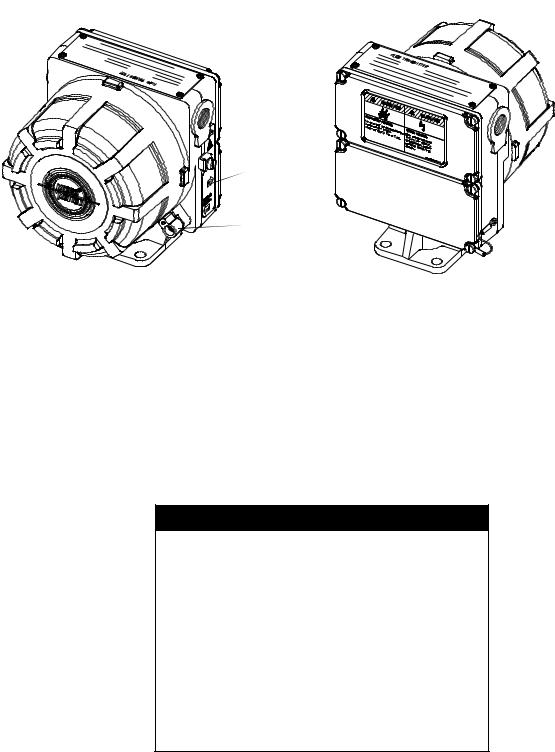
Getting Started continued
Figure 2-2 Compartment tags and lockout device
|
Circuit board |
|
compartment |
Field wiring |
Rated EEx d |
compartment |
|
Rated EEx e |
|
Label 1 |
Label 2 |
|
|
||
|
Sensor wiring |
|
Lockout device |
compartment |
|
Rated EEx i |
||
Loosen and rotate |
||
|
||
before opening |
|
|
circuit board |
|
|
compartment |
|
2.3Jumper settings
Unless otherwise specified on the order, jumpers are set so the transmitter generates downscale fault outputs and enables flowmeter configuration. If jumper settings need to be changed, the procedure should be performed before the transmitter is installed.
•To access security and fault output jumpers, unscrew the circuit board compartment cover.
•If the transmitter is approved by ATEX as flameproof, the compartment has a lockout device. See Figure 2-2. The lockout device must be loosened and rotated before the compartment cover can be unscrewed.


 CAUTION
CAUTION
Improper handling of transmitter components can damage the transmitter.
•If a breaker bar is used for loosening the cover of the circuit board compartment:
-Apply steady pressure to avoid chipping the paint on the transmitter housing. Chipped paint can result in corrosion of the housing. If paint becomes chipped, repaint the housing.
-Do not apply too much pressure. Excessive torque can damage the pipeline, transmitter, or sensor.
•To prevent electrostatic discharge, wear an anti-static wrist strap while setting jumpers.
8 |
Model IFT9701 Transmitter Instruction Manual |
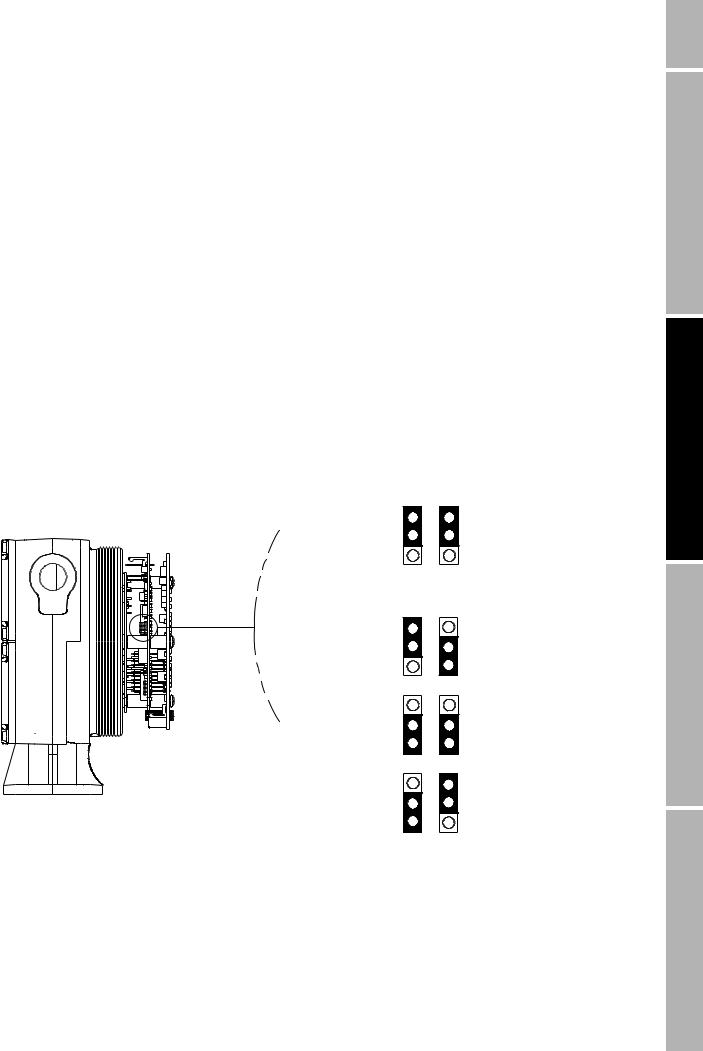
Getting Started continued
2.3.1Security
The security jumper enables the user to write-protect the flowmeter configuration, so it cannot be changed using a HART communication device:
•With the security jumper OFF, the flowmeter configuration can be changed.
•With the security jumper ON, the flowmeter configuration cannot be changed. The default setting is OFF. To set the security jumper, see Figure 2-3.
2.3.2Fault output levels
The transmitter can be configured to produce downscale or upscale fault outputs. In a fault condition:
•Downscale: The milliamp output goes to 2 mA; the pulse output goes to 0 Hz.
•Upscale: The milliamp output goes to 22 mA; the pulse output goes to 7200 Hz.
•The diagnostic LED blinks ON four times per second, whether the setting is upscale or downscale.
The default setting is downscale. To set the fault output jumper, see Figure 2-3.
Figure 2-3 Jumper location and settings
Default settings
With standoff beneath jumpers
Security |
Downscale |
OFF |
faults |
Optional settings
With standoff beneath jumpers
Security |
Upscale |
OFF |
faults |
Security |
Upscale |
ON |
faults |
Security |
Downscale |
ON |
faults |
Begin You Before
Started Getting
Transmitter Remote the Mounting
Wiring Output and Supply Power
Model IFT9701 Transmitter Instruction Manual |
9 |
|
|
|
|
Getting Started continued
2.3.3Re-installing the circuit board compartment cover
To re-install the cover of the circuit board compartment:
1.Screw the cover back onto the housing.
2.Hand-tighten the cover until it seats on the O-ring.
3.If the circuit board compartment has a lockout device, as shown in Figure 2-2, rotate the clamp into place and push it into the slot. Use a 4-mm (5/32-inch) Allen wrench to tighten the lockout screw to 5 inch-pounds (0,56 N-m) of torque.
10 |
Model IFT9701 Transmitter Instruction Manual |

Chapter 3
Remotely Mounting the Transmitter
Note: The instructions in this chapter apply only if the transmitter will be remotely mounted from the sensor. If the transmitter is integrally mounted to the sensor, proceed to Chapter 4.
3.1Overview
To mount the transmitter remotely from the sensor, the following steps are required:
•Choosing the proper location (see Section 3.2)
•Mounting the sensor on a flat surface or instrument pole (see Section 3.3)
•Connecting the transmitter to the sensor (see Section 3.4)
3.2Choosing the proper location
Install the transmitter according to the conditions stated in Section 2.1. For mounting dimensions, see Figure 3-1.
Total length of cable from sensor to transmitter must not exceed 1000 feet (300 meters).
For bend radii of cables, see Figure 3-4, Figure 3-5, or Figure 3-6, according to the type of cable to be used.
3.3Mounting the transmitter
A transmitter that is to be remotely mounted from the sensor is shipped with an L-shaped mounting bracket. Attach the bracket to a rigid, stable surface or instrument pole that will not transfer excessive vibration into the transmitter.
3.3.1Guidelines for flat-surface mounting
•Use four 5/16-inch (M8) nuts (not included), suitable for the environment.
•Do not secure bolts to separate beams, girders, wall studs, etc., which can move independently.
•To prevent unnecessary stress on the mounting bracket, use washers to shim the bracket if the mounting surface is not flat.
•For more information, see Figure 3-2.
3.3.2Guidelines for pole mounting
•Use two 5/16-inch (M8) U-bolts for 2-inch pipe, and four 5/16-inch (M8) nuts (not included), suitable for the environment.
•For more information, see Figure 3-3.
Begin You Before
Started Getting
Transmitter Remote the Mounting
Wiring Output and Supply Power
Model IFT9701 Transmitter Instruction Manual |
11 |
|
|
|
|
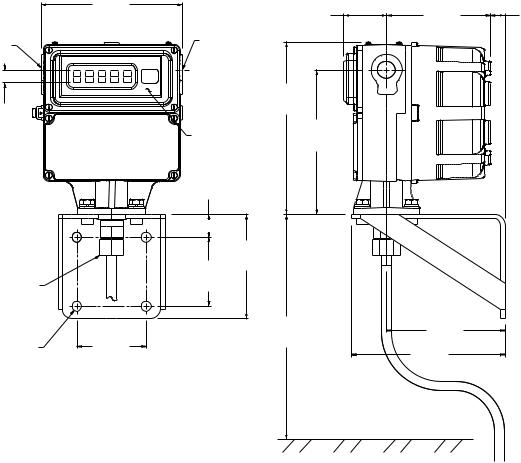
Remotely Mounting the Transmitter continued
Figure 3-1 Installation dimensions for remote mounting
Dimensions in inches (mm)
5 3/4
(146)
3/4″–14 NPT or M20 X 1.5 for power wiring
1/2
(13) Character height
3/4″–14 NPT gland for sensor wiring
4X Ø 25/64 |
2 13/16 |
(10)(71)
(1)If transmitter is ordered without display, dimension is 1 3/8 (35).
|
1 3/4 |
4 1/4 |
19/32 |
3/4″–14 NPT |
(44)(1) |
(107) |
(15) |
|
|
|
|
or M20 X 1.5 |
|
|
|
for output wiring |
|
|
|
|
7 1/64 |
|
|
|
(178) |
|
|
Field wiring |
2X 5 57/64 |
|
|
compartment |
(150) |
|
|
61/64 |
|
|
|
(24) |
|
|
|
4 1/4
2 13/16 (108)
(71)
4 53/64
9 43/64 (122)
(245)
6 17/64
(159)
For minimum bend radii of cable, see Figure 3-4,
Figure 3-5, or Figure 3-6
12 |
Model IFT9701 Transmitter Instruction Manual |
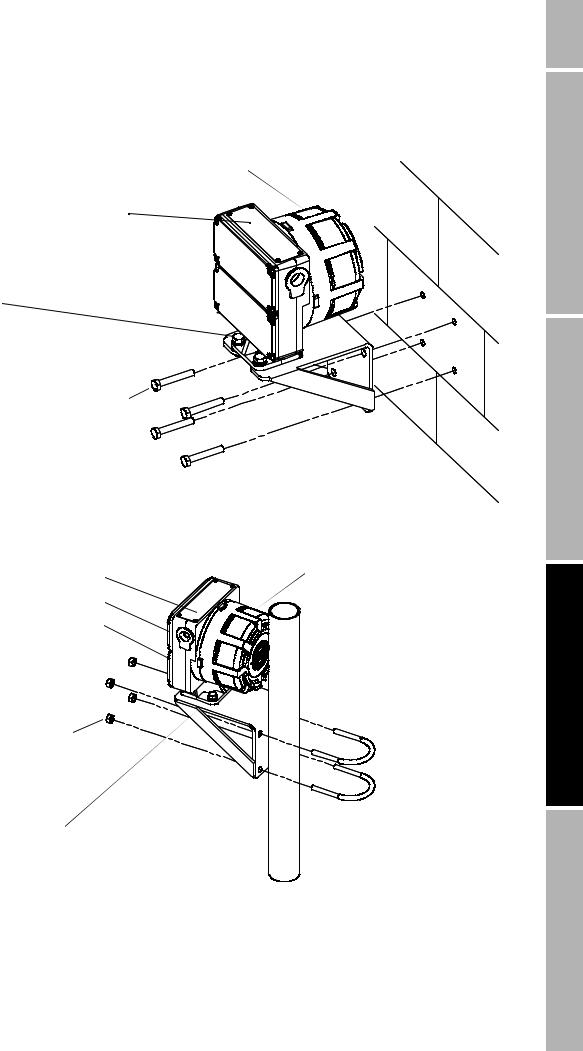
Remotely Mounting the Transmitter continued
Figure 3-2 Mounting the transmitter to a wall or other surface
Circuit board compartment 
User access not normally required
Area approvals tag
Field wiring compartment 
Sensor wiring compartment 


4X M8 bolt
4X lock washer
4X flat washer
To rotate transmitter: remove, then re-install to 12 ft-lb (16 N-m) torque
4X 5/16 (M8) bolt 
User-supplied
Figure 3-3 Mounting the transmitter to an instrument pole
Area approvals tag 
Field wiring compartment 
Sensor wiring compartment 
4X 5/16 (M8) bolt
User-supplied
4X M8 bolt
4X lock washer
4X flat washer
To rotate transmitter: remove, then re-install to 12 ft-lb (16 N-m) torque
 Circuit board compartment
Circuit board compartment
User access not normally required
2X 5/16-inch (M8) U-bolt for 2-inch pipe
User-supplied
Begin You Before
Started Getting
Transmitter Remote the Mounting
Wiring Output and Supply Power
Model IFT9701 Transmitter Instruction Manual |
13 |
|
|
|
|
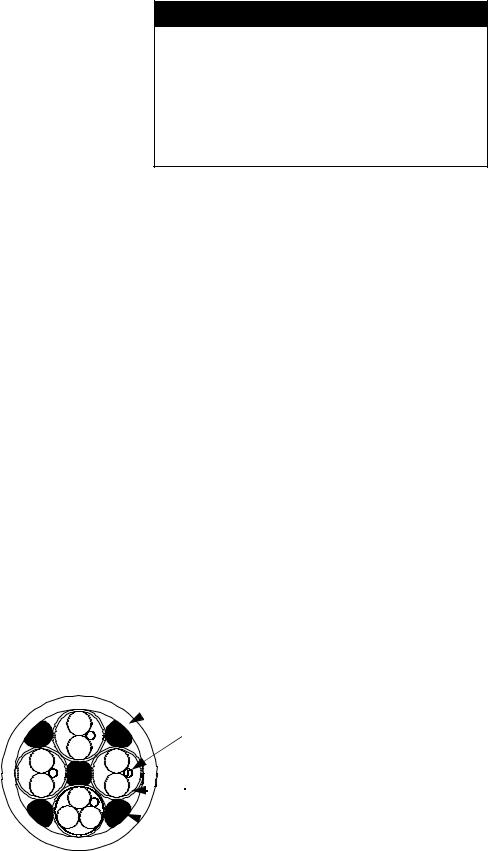
Remotely Mounting the Transmitter continued
3.4Connecting the transmitter to the sensor


 CAUTION
CAUTION
Improper installation of cable, cable gland, or conduit could cause inaccurate measurements or flowmeter failure.
To ensure 360° termination shielding for flowmeter wiring, install the factory-supplied cable gland or user-supplied sealed metallic conduit to the conduit opening on the sensor junction box.
To connect the transmitter to the sensor:
•Micro Motion 9-wire cable is required. See Section 3.4.1 for information on cable types offered by Micro Motion.
•Depending on your cable type, you must either install the cable in conduit or use cable glands. See Section 3.4.2 for information on conduit installations. See Section 3.4.3 for information on cable gland installations.
•For information on connecting the wires to the terminals, see Section 3.4.4.
Micro Motion’s 9-Wire Flowmeter Cable Preparation and Installation Guide, shipped with the cable, provides additional information on cable types, cable preparation, and installation requirements.
3.4.1Cable types
Micro Motion supplies 9-wire jacketed, shielded, or armored cable.
•Jacketed cable is CE-compliant when it is installed inside user-supplied sealed metallic conduit that provides 360° termination shielding for the enclosed cable. See Figure 3-4 for an illustration of jacketed cable.
•Shielded and armored cable are CE-compliant when the cable is installed with the factory-supplied cable glands. See Figure 3-5 for an illustration of shielded cable, and Figure 3-6 for an illustration of armored cable.
•Each cable type is available with a PVC or Teflon® FEP jacket. For temperature ranges of cable jacket materials, see Table 3-1.
See Table 3-2 for guidelines on cable selection. All cable types are acceptable for cable tray installation.
Figure 3-4 Jacketed cable
Jacket |
|
|
Minimum bend radii |
||
|
|
|
|
|
|
|
|
|
Static |
Under |
|
Drain wire (4) |
|
Outside |
(no load) |
dynamic |
|
Jacket |
diameter |
condition |
load |
||
|
|||||
|
material |
inches (mm) |
inches (mm) |
inches (mm) |
|
|
|
|
|
|
|
Foil shield (4) |
PVC |
0.415 (10) |
3 1/8 (80) |
6 1/4 (159) |
|
|
|
|
|
||
|
Teflon® |
0.340 (9) |
2 5/8 (67) |
5 1/8 (131) |
|
|
FEP |
|
|
|
|
 Filler (5)
Filler (5)
14 |
Model IFT9701 Transmitter Instruction Manual |
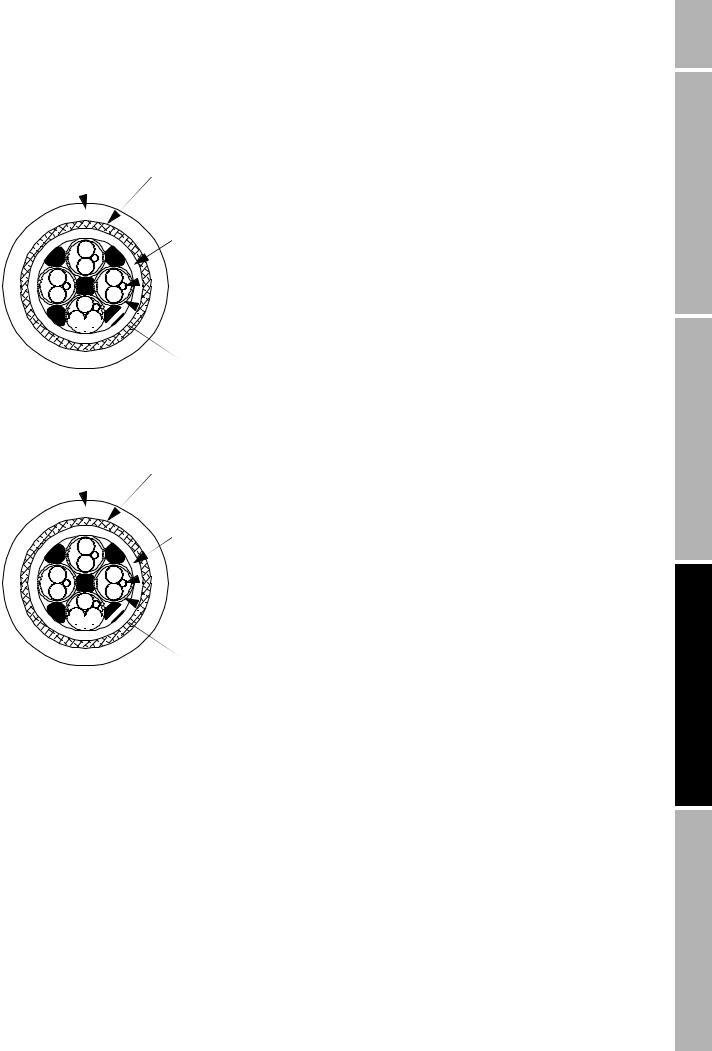
Remotely Mounting the Transmitter continued
Figure 3-5 Shielded cable
Outer jacket
Tin-plated copper braided shield
Foil shield (1)

 Inner jacket
Inner jacket
 Drain wire (4)
Drain wire (4)



 Foil shield (4)
Foil shield (4)
 Filler (5)
Filler (5)
|
|
|
Minimum bend radii |
|
|
|
Static |
Under |
|
|
Outside |
(no load) |
dynamic |
|
Jacket |
diameter |
condition |
load |
|
material |
inches (mm) |
inches (mm) |
inches (mm) |
|
|
|
|
|
|
PVC |
0.525 (14) |
4 |
1/4 (108) |
8 1/2 (216) |
|
|
|
|
|
Teflon® |
0.425 (11) |
3 |
1/4 (83) |
6 3/8 (162) |
FEP |
|
|
|
|
Figure 3-6 Armored cable
Outer jacket
Stainless steel braided shield
Foil shield (1)

 Inner jacket
Inner jacket
 Drain wire (4)
Drain wire (4)



 Foil shield (4)
Foil shield (4)
 Filler (5)
Filler (5)
|
|
|
Minimum bend radii |
|
|
|
Static |
Under |
|
|
Outside |
(no load) |
dynamic |
|
Jacket |
diameter |
condition |
load |
|
material |
inches (mm) |
inches (mm) |
inches (mm) |
|
PVC |
0.525 (14) |
4 |
1/4 (108) |
8 1/2 (216) |
Teflon® |
0.425 (11) |
3 |
1/4 (83) |
6 3/8 (162) |
FEP |
|
|
|
|
Table 3-1 Temperature ranges for jacket material
Jacket material |
Low operating temperature limit |
High operating temperature limit |
|
|
|
PVC |
–40 °F (–40 °C) |
221 °F (105 °C) |
|
|
|
Teflon® FEP |
–76 °F (–60 °C) |
302 °F (150 °C) |
|
|
|
Table 3-2 Cable selection guidelines
Installation requirements |
Jacketed cable |
Shielded cable |
Armored cable |
|
|
|
|
Conduit is used |
|
|
|
|
|
|
|
Conduit is not used |
|
|
|
|
|
|
|
Conduit is not used and |
|
|
|
mechanical protection is required |
|
|
|
|
|
|
|
Begin You Before
Started Getting
Transmitter Remote the Mounting
Wiring Output and Supply Power
Model IFT9701 Transmitter Instruction Manual |
15 |
|
|
|
|

Remotely Mounting the Transmitter continued
3.4.2Guidelines for conduit
If sealed metallic conduit is installed, it must provide 360° termination shielding for the enclosed flowmeter cable.
1.Install a drip leg in conduit to prevent liquids from entering the junction box.
2.Connect the sealed end of the conduit to the ¾-inch NPT female conduit opening on the sensor junction box.
3.4.3Guidelines for cable gland
1.Prepare cable ends and assemble the supplied cable gland according to the instructions that are enclosed with the cable preparation kit.
2.Connect the ¾-inch NPT male cable gland to the ¾-inch NPT female conduit opening on the sensor junction box.
3.4.4Wiring connections to sensor
1.At the sensor, insert the ends of the individual wires into the terminals inside the sensor junction box. Match the wire colors of the cable with the wire colors at the sensor wiring terminal as described in Figure 3-7 and Table 3-3. No bare wire should remain exposed.
2.If possible, position the junction box on the sensor so the conduit entrance points downward to prevent moisture from entering.
3.At the transmitter, if cable is not preinstalled, connect the cable to the transmitter terminals as indicated in Figure 3-8.


 WARNING
WARNING
Failure to seal sensor junction box or transmitter housing could cause a short circuit, which would result in measurement error or flowmeter failure.
•Seal all conduit openings.
•Install drip legs in cable or conduit.
•Fully tighten sensor junction box and transmitter housing covers. See Figure 3-8.
16 |
Model IFT9701 Transmitter Instruction Manual |
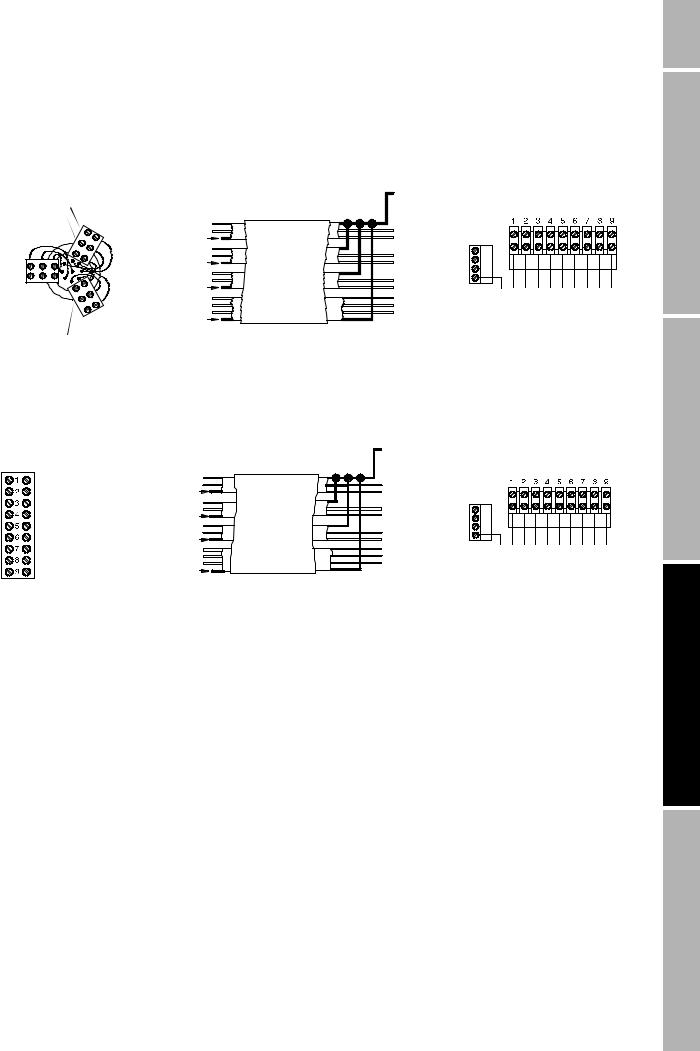
Remotely Mounting the Transmitter continued
Figure 3-7 Cable connections to sensors
ELITE and F-Series
sensor terminals
Green
White
Brown
Violet 
Yellow 
Orange 
 Blue
Blue
 Gray
Gray
 Red
Red
Flowmeter
cable
|
Maximum cable length 1000 ft. (330 m) |
|
|
|
Black |
|
|
|
(Drains from all |
||
|
wire sets) |
|
|
Brown |
|
|
|
Red |
Brown |
|
|
Clip drain wire back |
Red |
|
|
Green |
Green |
10 |
|
White |
|||
11 |
|||
Clip drain wire back |
White |
||
Blue |
Blue |
12 |
|
Gray |
GND |
||
Clip drain wire back |
Gray |
|
|
Orange |
Orange |
|
|
Violet |
Violet |
|
|
Yellow |
Yellow |
|
|
Clip drain wire back |
|
|
|
Prepare cable in accordance with the instructions that are shipped with the cable
IFT9701 terminals
Black (Drains, remote-mount only) |
Brown |
Red |
Orange |
Yellow |
Green |
Blue |
Violet |
Gray |
White |
D and DL sensor terminals*
Brown
Red
Orange
Yellow
Green
Blue
Violet
Gray
White
Flowmeter
cable
|
Maximum cable length 1000 ft. (300 m) |
|
Black |
|
(Drains from all |
|
wire sets) |
Brown |
|
Red |
Brown |
Clip drain wire back |
Red |
Green |
Green |
White |
|
Clip drain wire back |
White |
Blue |
|
Gray |
Blue |
Clip drain wire back |
Gray |
Orange |
Orange |
Violet |
Violet |
Yellow |
Yellow |
Clip drain wire back |
|
Prepare cable in accordance with the instructions that are shipped with the cable
*Model D600 and DT sensors cannot be used with IFT9701 transmitters
IFT9701 terminals
10
11
12 GND
Black (Drains, remote-mount only) |
Brown |
Red |
Orange |
Yellow |
Green |
Blue |
Violet |
Gray |
White |
Table 3-3 Sensor terminal designations
Terminal number |
Wire color |
Function |
|
|
|
1 |
Brown |
Drive + |
|
|
|
2 |
Red |
Drive – |
|
|
|
3 |
Orange |
Temperature – |
|
|
|
4 |
Yellow |
Temperature lead length compensator |
|
|
|
5 |
Green |
Left pickoff + |
|
|
|
6 |
Blue |
Right pickoff + |
|
|
|
7 |
Violet |
Temperature + |
|
|
|
8 |
Gray |
Right pickoff – |
|
|
|
9 |
White |
Left pickoff – |
|
|
|
Begin You Before
Started Getting
Transmitter Remote the Mounting
Wiring Output and Supply Power
Model IFT9701 Transmitter Instruction Manual |
17 |
|
|
|
|
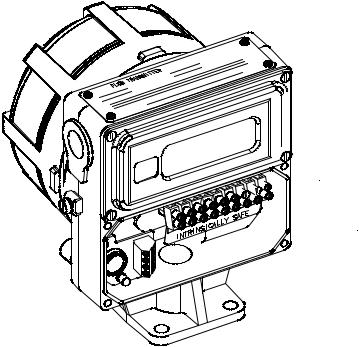
Remotely Mounting the Transmitter continued
Figure 3-8 Sensor wiring compartment and sensor wiring terminals
Sensor wiring 

 terminals
terminals
 Sensor wiring compartment
Sensor wiring compartment
18 |
Model IFT9701 Transmitter Instruction Manual |

Chapter 4
Power Supply and Output Wiring
4.1Overview
To wire the transmitter power supply and outputs:
•Review the wiring guidelines (see Section 4.2)
•Connect the power supply wiring (see Section 4.3)
•Connect the output wiring (see Section 4.4)
4.2Wiring guidelines
•Install cable and wiring so they meet local code requirements.
•The transmitter has two separate ¾-inch NPT or M20 female conduit openings, which must remain sealed to keep the transmitter watertight. See Figure 4-1 and Figure 4-2.
•The transmitter has a sensor wiring compartment for intrinsically safe sensor wiring, and a field wiring compartment for non-intrinsically safe power supply and output wiring. See Figure 4-1 and Figure 4-2.
-For power supply and output wiring, loosen the four captive screws that secure the cover of the field wiring compartment.
-Access to the sensor wiring and circuit board compartments is not required for power supply and output wiring.
Begin You Before
Started Getting
Transmitter Remote the Mounting
Wiring Output and Supply Power
Model IFT9701 Transmitter Instruction Manual |
19 |
|
|
|
|
